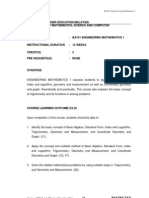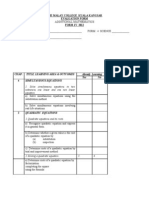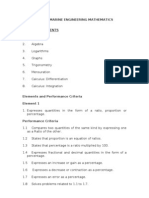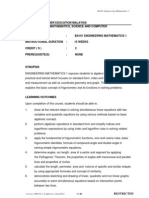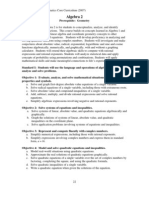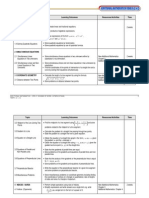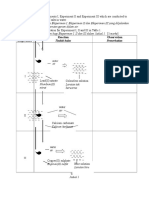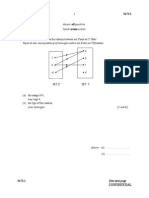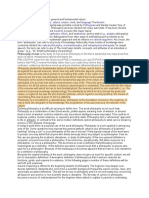f5 Add Maths Annual Scheme (2008)
f5 Add Maths Annual Scheme (2008)
Uploaded by
Abdul ManafCopyright:
Available Formats
f5 Add Maths Annual Scheme (2008)
f5 Add Maths Annual Scheme (2008)
Uploaded by
Abdul ManafOriginal Description:
Original Title
Copyright
Available Formats
Share this document
Did you find this document useful?
Is this content inappropriate?
Copyright:
Available Formats
f5 Add Maths Annual Scheme (2008)
f5 Add Maths Annual Scheme (2008)
Uploaded by
Abdul ManafCopyright:
Available Formats
FORM 5 ADDITIONAL MATHEMATICS
ANNUAL SCHEME OF WORK
1. PROGRESSIONS
Month /
Week
Learning
Objectives
3W
1. Understand
and use the
concept of
arithmetic
progression.
JAN
W1-2
JAN
W2-3
Learning Outcomes
1.1
Identify characteristics of arithmetic progressions.
1.2
Determine whether a given sequence is an arithmetic progression.
1.3
Determine by using formula:
a) specific terms in arithmetic progressions;
b) the number of terms in arithmetic progressions.
1.4
Find:
Points To Note
Begin with sequences to introduce
arithmetic and geometric progressions.
Include examples in algebraic form.
Include the use of the formula
Tn S n S n 1
a)
the sum of the first n terms of arithmetic progressions.
b)
the sum of a specific number of consecutive terms of arithmetic
progressions.
c)
the value of n, given the sum of the first n terms of arithmetic
progressions.
1.5
Solve problems involving arithmetic progressions.
2.1
2.2
2.3
Identify characteristics of geometric progressions.
Determine whether a given sequence is a geometric progression.
Determine by using formula:
Include problems involving real-life
situations.
a) specific terms in
geometric progressions,
b) the number of terms in
geometric progressions.
2.4
2.5
Find:
a) the sum of the first n terms of
of geometric progressions;
b)
the sum of a specific number of consecutive terms of geometric
progressions.
c)
the value of n, given the sum of the first n terms of geometric
progressions.
Find:
a)
b)
Discuss:
n ,r 0
the sum to infinity of geometric progressions.
As
the first term or common ratio, given the sum to infinity of geometric
progressions.
S read as sum to infinity.
then Sa =
1r
Include recurring decimals. Limit to 2
recurring digits such as 0.
3,
. .
2.6
Solve problems involving geometric progressions.
0.15 ,
Exclude:
a)
combination of arithmetic
progressions and geometric
progressions.
b) cumulative
sequences such as,
(1), (2,3), (4,5,6),
(7,8,9,10),
2. LINEAR LAW
3W
JAN
W4-5
FEB
W1
1.
Understand and
use the concept
of lines of best
fit.
1.1
Draw lines of best fit by inspection of given data.
1.2
Write equations for lines of best fit.
1.3
Determine values of variables from:
a) lines of best fit
b) equations of lines of best fit.
2. Apply
linear law to
non-linear
relations.
2.1
Reduce non-linear relations to linear form.
2.2
Determine values of constants of non-linear relations given:
a) lines of best fit
b) data.
2.3
Obtain information from:
a) lines of best fit
Limit data to linear relations between
two variables.
MAS : Students must be
able to follow instruction &
draw the line of best fit
b) equations of lines of best fit.
3. INTEGRATION
Month /
Week
Learning
Objectives
4W
1.
Understand and
use the concept
of indefinite
integral.
FEB
W2-4
Mac
W1
2.
Understand and
use the concept
of definite
integral.
Learning Outcomes
1.1
1.2
1.3
1.4
1.5
Determine integrals by reversing differentiation.
Determine integrals of axn, where a is a constant and n is an integer,
n 1.
Determine integrals of algebraic expressions.
Find constants of integration, c, in indefinite integrals.
Determine equations of curves from functions of gradients.
Points To Note
Emphasise constant of integration.
ydx
read as integration of y
with respect to x
Limit integration of
dx,
1.6
Determine by substitution the integrals of expressions of the form (ax + b)n,
where a and b are constants, n is an integer and
n 1.
2.1
Find definite integrals of algebraic expressions.
Include
2.2
Find areas under curves as the limit of a sum of areas.
2.3
Determine areas under curves using formula.
Derivation of formulae not required.
where u = ax + b.
a
b
2.4
kf ( x )dx k f ( x) dx
a
a
f ( x) dx f ( x) dx
b
Find volumes of revolutions when region bounded by a curve is rotated
completely about the
Limit to one curve.
a) x-axis
Derivation of formulae not required.
b) y-axis
as the limit of a sum of volumes.
2.5
Determine volumes of revolutions using formula.
Limit volumes of revolution about the
x-axis or y-axis.
8 16 MAC 2008 : MID-TERM HOLIDAYS..
4. VECTORS
Month /
Week
3W
Learning Objectives
1. Understand
and use the concept
of vector.
Learning Outcomes
1.1
1.2
1.3
MAC
W3-4
APR
W1
Differentiate between vector and scalar quantities.
Draw and label directed line segments to represent vectors.
Determine the magnitude and direction of vectors represented by directed
line segments.
1.4
Determine whether two vectors are equal.
1.5
Multiply vectors by scalars.
Points To Note
Use notations:
Vector:
~ a, AB, a, AB.
Magnitude:
|a|,~|AB|, |a|, |AB|.
~0
Zeto vector:
Emphasise that a zero vector has a
magnitude of zero.
Emphasise negative vector:
AB = BA
Include negative scalar.
1.6
Determine whether two vectors are parallel.
Include:
a)
b)
collinear points
non-parallel non-zero
vectors.
Emphasise:
~ b are not parallel and~ha =~ kb,
~If a and
then
h = k = 0.
2. Understand
and use the concept
of addition and
subtraction of
vectors.
2.1
Determine the resultant vector of two parallel vectors.
2.2
Determine the resultant vector of two non-parallel vectors using:
a) triangle law
b) parallelogram law.
Determine the resultant vector of three or more vectors using the polygon
law.
2.3
2.4
Subtract two vectors which are:
a)
parallel
b)
non-parallel.
2.5
Represent vectors as a combination of other vectors.
Emphasise:
~ b~= a + ~(b)
a~
2.6
Solve problems involving addition and subtraction of vectors.
Cont.. (VECTORS)
3. Understand
and use vectors in
the Cartesian plane.
Relate unit vector
~ j to Cartesian
~ i and
coordinates.
Emphasise:
3.1 Express vectors in the form:
a)~ xi~+ yj
b)
x
y
vector
vector
3.2
Determine magnitudes of vectors.
3.3
Determine unit vectors in given directions.
1
i =
0
j
~
~
3.4 Add two or more vectors.
Subtract two vectors.
3.6
Multiply vectors by scalars.
3.7
Perform combined operations on vectors.
0
1
For learning outcomes 3.2 to 3.7, all
vectors are given in the form
x
~ y
xi + yj or
3.5
and
Limit combined operations to
addition, subtraction and
multiplication of vectors by scalars.
3.8 Solve problems involving vectors.
5. TRIGONOMETRY
Month /
Week
APR
W2-4
Learning Objectives
Learning Outcomes
Points To Note
1. Understand
the concept of
positive and
negative angles
measured in degrees
and radians.
1.1
Represent in a Cartesian plane, angles greater than 360o or 2 radians for:
a) positive angles
b) negative angles.
2. Understand
and use the six
trigonometric
functions of any
angle.
2.1
Define sine, cosine and tangent of any angle in a Cartesian plane.
2.2
Define cotangent, secant and cosecant of any angle in a Cartesian plane.
2.3
Find values of the six trigonometric functions of any angle.
2.4
Solve trigonometric equations.
3.1
Draw and sketch graphs of trigonometric functions:
a) y = c + a sin bx,
b) y = c + a cos bx,
c) y = c + a tan bx
where a, b and c are constants and b > 0.
3. Understand
and use graphs of
sine, cosine and
tangent functions.
4. Understand
and use basic
identities.
5. Understand and
use
addition
formulae and
double-angle
formulae.
Use unit circle to determine the sign of
trigonometric ratios.
Emphasise:
sin = cos (90o )
cos = sin (90o )
tan = cot (90o )
cosec = sec (90o )
sec = cosec (90o )
cot = tan (90o )
Emphasise the use of triangles to find
trigonometric ratios for special angles
30o, 45o and 60o.
Use angles in
a) degrees
b) radians, in terms of .
Emphasise the characteristics of sine,
cosine and tangent graphs.
Include trigonometric functions
involving modulus.
3.2
Determine the number of solutions to a trigonometric equation using
sketched graphs.
3.3
Solve trigonometric equations using drawn graphs.
Exclude combinations of
trigonometric functions.
4.1
Basic identities are also known as
Pythagorean identities.
4.2
Prove basic identities:
a) sin2A + cos2A = 1
b) 1 + tan2A = sec2A
c) 1 + cot2A = cosec2A
Prove trigonometric identities using basic identities.
4.3
Solve trigonometric equations using basic identities.
5.1
Prove trigonometric identities using addition formulae for
cos (A B) and
tan (A B).
5.2
Derive double-angle formulae for sin 2A, cos 2A and tan 2A.
5.3
Prove trigonometric identities using addition formulae and/or double-angle
formulae.
5.4
Solve trigonometric equations.
Include learning outcomes 2.1 and 2.2.
sin (A B),
Derivation of addition formulae not
required.
Discuss half-angle formulae.
Exclude
A cosx + b sinx = c,
where c 0.
10. LINEAR PROGRAMMING
Month /
Week
Learning
Objectives
2W
1.
Understand and
use the concept
of graphs of
linear
inequalities.
MAY
W1 2
2.
Understand and
use the concept
of linear
programming.
Learning Outcomes
1.1
Identify and shade the region on the graph that satisfies a linear inequality.
1.2
Find the linear inequality that defines a shaded region.
1.3
Shade region on the graph that satisfies several linear inequalities.
1.4
Find linear inequalities that define a shaded region.
2.1
Points To Note
Emphasise the use of solid lines and
dashed lines.
Limit to regions defined by a
maximum of 3 linear inequalities (not
including the x-axis and y-axis).
Solve problems related to linear programming by:
a)
writing linear inequalities and equations describing a situation.
b)
shading the region of feasible solutions.
Optimum values refer to maximum or
minimum values.
c)
determining and drawing the objective function ax + by = k where a, b
and k are onstants.
Include the use of vertices to find the
optimum value.
d)
determining graphically the optimum value of the objective function.
MID-YEAR EXAMINATIONS
6. PERMUTATIONS AND COMBINATIONS
Month /
Week
Learning
Objectives
2W
1.
Understand and
use the concept
of permutation.
JUNE
Learning Outcomes
Points To Note
For this topic:
a)
Intro
duce the concept by using
numerical examples.
a) Calculators should only be
used after students have
understood the concept.
W2 3
Limit to 3 events.
1.1
Determine the total number of ways to perform successive events using
multiplication rule.
1.2
Determine the number of permutations of n different objects.
Exclude cases involving identical
objects.
Explain the concept of permutations
by listing all possible arrangements.
Include notations:
b)
n! =
n(n 1)(n 2)(3).(2).(1)
c) 0! = 1
n! read as n factorial.
2. Understand
and use the
concept of
combination.
1.3
Determine the number of permutations of n different objects taken r at a
time.
Exclude cases involving arrangement
of objects in a circle.
1.4
Determine the number of permutations of n different objects for given
conditions.
1.5
Determine the number of permutations of n different objects taken r at a time for
given conditions.
2.1
Determine the number of combinations of r objects chosen from n different
objects.
Explain the concept of combinations
by listing all possible selections.
2.2
Determine the number of combinations r objects chosen from n different
objects for given conditions.
Use examples to illustrate
Cr
Pr
r!
7. PROBABILITY
Month /
Week
3W
JUN
W4
Learning Objectives
1. Understand and
use the concept of
probability.
Learning Outcomes
1.1
Describe the sample space of an experiment.
1.2
Determine the number of outcomes of an event.
1.3
Determine the probability of an event.
Points To Note
Use set notations.
i.
JULY
W1-2
Discuss:
a) classical probability
(theoretical probability)
iii.
b) subjective probability
iv.
c) relative frequency
probability (experimental
probability).
ii.
Emphasise:
Only classical probability is used to solve
problems.
1.4
Determine the probability of two events:
a)
A or B occurring
b)
A and B occurring.
Emphasise:
P(A
B) = P(A)+P(B)
P(A
B)
using Venn diagrams.
2. Understand and
use the concept of
probability of mutually
exclusive events.
2.1
Determine whether two events are mutually exclusive.
Include events that are mutually exclusive
and exhaustive.
2.2
Determine the probability of two or more events that are mutually
exclusive.
Limit to three mutually exclusive events.
3. Understand and
use the concept of
probability of
independent events.
3.1
Determine whether two events are independent.
Include tree diagrams.
3.2
Determine the probability of two independent events.
3.3
Determine the probability of three independent events.
8. PROBABILITY DISTRIBUTIONS
Month /
Week
2W
JULY
Learning
Objectives
Learning Outcomes
1.
Understand and
use the concept
of binomial
distribution.
1.1
2.
Understand and
use the concept
of normal
distribution.
Points To Note
1.2
List all possible values of a discrete random variable.
Determine the probability of an event in a binomial distribution.
1.3
1.4
1.5
Plot binomial distribution graphs.
Determine mean, variance and standard deviation of a binomial distribution.
Solve problems involving binomial distributions.
For learning outcomes 1.2 and 1.4,
derivation of formulae not required.
2.1
Describe continuous random variables using set notations.
2.2
Find probability of z-values for standard normal distribution.
Discuss characteristics of:
a) normal distribution graphs
b) standard normal distribution
graphs.
2.3
Convert random variable of normal distributions, X, to standardised
variable,Z.
Z is called standardised variable.
2.4
Represent probability of an event using set notation.
2.5
Determine probability of an event.
2.6
Solve problems involving normal distributions.
Include the characteristics of Bernoulli
trials.
W3-4
Integration of normal distribution
function to determine probability is
not required.
9. MOTION IN A STRAIGHT LINE
Month /
Week
Learning
Objectives
3W
1. Understand
and use
the
concept of
displacement.
JUL
W5
Learning Outcomes
1.1
1.2
1.3
Identify direction of displacement of a particle from a fixed point.
Determine displacement of a particle from a fixed point.
Determine the total distance travelled by a particle over a time interval using
graphical method.
AUG
W1-2
Points To Note
Emphasise the use of the following
symbols:
s = displacement
v = velocity
a = acceleration
t = time
where s, v and a are functions of time.
Emphasise the difference between
displacement and distance.
Discuss positive, negative and zero
displacements.
Include the use of number line.
2. Understand
and use the
concept of
velocity.
3.
Understand and
use the concept
of acceleration.
2.1
Determine velocity function of a particle by differentiation.
Emphasise velocity as the rate of change
of displacement.
Include graphs of velocity functions.
2.2
Determine instantaneous velocity of a particle.
2.3
Determine displacement of a particle from velocity function by integration.
3.1
Determine acceleration function of a particle by differentiation.
3.2
Determine instantaneous acceleration of a particle.
3.3
Determine instantaneous velocity of a particle from acceleration function by
integration.
3.4
Determine displacement of a particle from acceleration function by
integration.
3.5
Solve problems involving motion along a straight line.
Discuss:
a) uniform velocity
b) zero instantaneous
velocity
c) positive velocity
d) negative velocity.
Emphasise acceleration as the rate of
change of velocity.
Discuss:
a) uniform
acceleration
b) zero acceleration
c) positive
acceleration
d) negative
acceleration.
AUGUST - .
STRATEGIC REVISION BASED ON PAST-YEAR QUESTIONS AND JUJ QUESTIONS
SEPTEMBER
SPM TRIAL EXAMINATIONS
OCTOBER-NOVEMBER
STRATEGIC REVISION BASED ON PAST-YEAR QUESTIONS AND OTHER STATES TRIAL EXAM QUESTIONS
NOVEMBER
DECEMBER
SPM 2008
. GOOD LUCK!!!
You might also like
- Maths in Focus Worked Solutions Yr 11 Adv Ch7No ratings yetMaths in Focus Worked Solutions Yr 11 Adv Ch762 pages
- Sekolah Menengah Kebangsaan Air Molek Form 5 Additional Mathematics Scheme of Work 2013No ratings yetSekolah Menengah Kebangsaan Air Molek Form 5 Additional Mathematics Scheme of Work 201315 pages
- Week/ Date Learning Objective Learning Outcomes Value NotesNo ratings yetWeek/ Date Learning Objective Learning Outcomes Value Notes9 pages
- Additional Mathematics: FORM 4 / 2011 WE EK Topics/Learning Area Learning Outcomes Points To NoteNo ratings yetAdditional Mathematics: FORM 4 / 2011 WE EK Topics/Learning Area Learning Outcomes Points To Note15 pages
- Form Four Additional Mathematics Yearly Plan 200No ratings yetForm Four Additional Mathematics Yearly Plan 20010 pages
- Advanced Algebra Trig Pacing Guide: Big Ideas Enduring Understandings Essential QuestionsNo ratings yetAdvanced Algebra Trig Pacing Guide: Big Ideas Enduring Understandings Essential Questions11 pages
- Students Will Be Taught To Students Will Be Able ToNo ratings yetStudents Will Be Taught To Students Will Be Able To17 pages
- GCE N Level Add-Mathematics (4039 - 2012)No ratings yetGCE N Level Add-Mathematics (4039 - 2012)13 pages
- Course Title: Technical Mathematics Course Code: Course Category: F Periods/Week: 6 Periods/Semester: 108 Credits: 6No ratings yetCourse Title: Technical Mathematics Course Code: Course Category: F Periods/Week: 6 Periods/Semester: 108 Credits: 64 pages
- School: SM Agama Kota Tinggi Subject: Mathematics Form: 2No ratings yetSchool: SM Agama Kota Tinggi Subject: Mathematics Form: 27 pages
- Chap 3 Parallel and Perpendicular LinesNo ratings yetChap 3 Parallel and Perpendicular Lines17 pages
- Tingkatan 2 Week Learning Area Learning Objectives Learning Outcomes Remark 1. Directed NumbersNo ratings yetTingkatan 2 Week Learning Area Learning Objectives Learning Outcomes Remark 1. Directed Numbers8 pages
- Add Maths Fast Track Sow Year 9 310807 v2No ratings yetAdd Maths Fast Track Sow Year 9 310807 v29 pages
- Ranc Pengajaran Tahunan F5 MmYearlyPlan 2014No ratings yetRanc Pengajaran Tahunan F5 MmYearlyPlan 201417 pages
- School: SMK Dato' Sri Amar Diraja, Muar Subject: Mathematics Form: 2No ratings yetSchool: SMK Dato' Sri Amar Diraja, Muar Subject: Mathematics Form: 28 pages
- Contact Hour Per Week: 04 Contact Hour Per Semester: 64No ratings yetContact Hour Per Week: 04 Contact Hour Per Semester: 6415 pages
- Explorations and Discoveries in Mathematics, Volume 1, Using The Geometer's Sketchpad Version 4From EverandExplorations and Discoveries in Mathematics, Volume 1, Using The Geometer's Sketchpad Version 4No ratings yet
- Advanced Numerical Methods with Matlab 2: Resolution of Nonlinear, Differential and Partial Differential EquationsFrom EverandAdvanced Numerical Methods with Matlab 2: Resolution of Nonlinear, Differential and Partial Differential EquationsNo ratings yet
- Binomial Distribution (Taburan Binomial) : Example 1No ratings yetBinomial Distribution (Taburan Binomial) : Example 114 pages
- Experiment Reaction Observation: Study The Solubility of Salts in WaterNo ratings yetExperiment Reaction Observation: Study The Solubility of Salts in Water10 pages
- Set 9 p1 3472/1: Answer All Questions. Jawab Semua SoalanNo ratings yetSet 9 p1 3472/1: Answer All Questions. Jawab Semua Soalan11 pages
- Final Updated - Me Robotics and Automation Syllabus 2021No ratings yetFinal Updated - Me Robotics and Automation Syllabus 2021115 pages
- Combined Mathematics Teacher Training Manual - INo ratings yetCombined Mathematics Teacher Training Manual - I141 pages
- Application of Revised Simplex Method For Profit MaximizationNo ratings yetApplication of Revised Simplex Method For Profit Maximization15 pages
- Analysis of Population Growth of India and Estimation For FutureNo ratings yetAnalysis of Population Growth of India and Estimation For Future8 pages
- Stresses in Finite Anisotropic Plate Weakened by Rectangular HoleNo ratings yetStresses in Finite Anisotropic Plate Weakened by Rectangular Hole8 pages
- Probabilistic Methods in Engineering: Exercise Set 4No ratings yetProbabilistic Methods in Engineering: Exercise Set 43 pages
- McCormick How Stable Diffusion Works Dec 2022No ratings yetMcCormick How Stable Diffusion Works Dec 202213 pages
- Continuum Mechanics: Concise Theory and ProblemsFrom EverandContinuum Mechanics: Concise Theory and Problems
- Sekolah Menengah Kebangsaan Air Molek Form 5 Additional Mathematics Scheme of Work 2013Sekolah Menengah Kebangsaan Air Molek Form 5 Additional Mathematics Scheme of Work 2013
- Week/ Date Learning Objective Learning Outcomes Value NotesWeek/ Date Learning Objective Learning Outcomes Value Notes
- Additional Mathematics: FORM 4 / 2011 WE EK Topics/Learning Area Learning Outcomes Points To NoteAdditional Mathematics: FORM 4 / 2011 WE EK Topics/Learning Area Learning Outcomes Points To Note
- Advanced Algebra Trig Pacing Guide: Big Ideas Enduring Understandings Essential QuestionsAdvanced Algebra Trig Pacing Guide: Big Ideas Enduring Understandings Essential Questions
- Students Will Be Taught To Students Will Be Able ToStudents Will Be Taught To Students Will Be Able To
- Course Title: Technical Mathematics Course Code: Course Category: F Periods/Week: 6 Periods/Semester: 108 Credits: 6Course Title: Technical Mathematics Course Code: Course Category: F Periods/Week: 6 Periods/Semester: 108 Credits: 6
- School: SM Agama Kota Tinggi Subject: Mathematics Form: 2School: SM Agama Kota Tinggi Subject: Mathematics Form: 2
- Tingkatan 2 Week Learning Area Learning Objectives Learning Outcomes Remark 1. Directed NumbersTingkatan 2 Week Learning Area Learning Objectives Learning Outcomes Remark 1. Directed Numbers
- School: SMK Dato' Sri Amar Diraja, Muar Subject: Mathematics Form: 2School: SMK Dato' Sri Amar Diraja, Muar Subject: Mathematics Form: 2
- Contact Hour Per Week: 04 Contact Hour Per Semester: 64Contact Hour Per Week: 04 Contact Hour Per Semester: 64
- Explorations and Discoveries in Mathematics, Volume 1, Using The Geometer's Sketchpad Version 4From EverandExplorations and Discoveries in Mathematics, Volume 1, Using The Geometer's Sketchpad Version 4
- A-level Maths Revision: Cheeky Revision ShortcutsFrom EverandA-level Maths Revision: Cheeky Revision Shortcuts
- Advanced Numerical Methods with Matlab 2: Resolution of Nonlinear, Differential and Partial Differential EquationsFrom EverandAdvanced Numerical Methods with Matlab 2: Resolution of Nonlinear, Differential and Partial Differential Equations
- Binomial Distribution (Taburan Binomial) : Example 1Binomial Distribution (Taburan Binomial) : Example 1
- Experiment Reaction Observation: Study The Solubility of Salts in WaterExperiment Reaction Observation: Study The Solubility of Salts in Water
- Set 9 p1 3472/1: Answer All Questions. Jawab Semua SoalanSet 9 p1 3472/1: Answer All Questions. Jawab Semua Soalan
- Final Updated - Me Robotics and Automation Syllabus 2021Final Updated - Me Robotics and Automation Syllabus 2021
- Application of Revised Simplex Method For Profit MaximizationApplication of Revised Simplex Method For Profit Maximization
- Analysis of Population Growth of India and Estimation For FutureAnalysis of Population Growth of India and Estimation For Future
- Stresses in Finite Anisotropic Plate Weakened by Rectangular HoleStresses in Finite Anisotropic Plate Weakened by Rectangular Hole
- Probabilistic Methods in Engineering: Exercise Set 4Probabilistic Methods in Engineering: Exercise Set 4


















